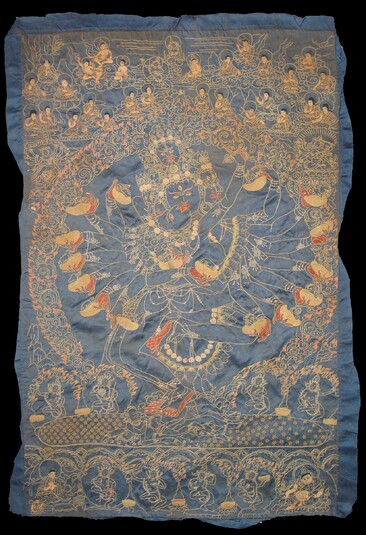
Item: Hevajra (Buddhist Deity)
| Origin Location | Tibet |
|---|---|
| Date Range | 1800 - 1899 |
| Lineages | Sakya and Buddhist |
| Material | Black Background on Textile Image, Embroidery |
| Collection | Rubin Museum of Art |
Classification: Deity
Shri Hevajra is a principal meditational deity of the Anuttarayoga classification in Buddhist Tantra. According to the Sakya system Hevajra belongs to the sub-class of 'non-dual' tantra. From the numerous texts within the cycle of Hevajra the root Tantra of 'Two Sections' is the most important.
Sanskrit: Hevajra Tibetan: Gye pa dor je
Tibetan: Gye pa dor je
At the top center and to the right and left are the lineage teachers descending from Vajradhara, Nairatmya and Virupa. Below that, on the left side is the meditational deity Chakrasamvara. On the right side is the meditational deity Guhyasamaja.
The large central subject of the textile composition is Shri Hevajra and the consort Vajra Nairatmya.
"...Shri Hevajra with a body blue in colour, eight faces, sixteen hands and four legs. The main face is blue, right white, left red, upper face smoky; the two remaining pairs of faces are black. Each face has three eyes and four bared fangs; yellow hair flowing upwards; the top of the head is marked with a vishvavajra. The sixteen hands hold sixteen skullcups. The first right holds a white elephant, the first left holds the yellow God of Earth; these two embrace the Mother. In the second right is a blue horse; third - ass with a white patch; fourth - yellow bull; fifth - ash-coloured camel; sixth - red man; seventh - blue sharabha; eighth - cat with a white patch. In the second left hand is the white God of Water; third - red God of Fire; fourth - green God of Air; fifth - white God of the Moon; sixth - red God of the Sun; seventh - blue Yama; eighth - yellow Holder of Wealth. Each head has a crown of five dry human skulls; and a necklace of fifty fresh heads; six bone ornaments; the two right legs are extended, on the thighs the toes of the two folded left legs are pressing in the half-[vajra] posture in a dancing manner; possessing the nine sentiments of dancing: grace, strength and ugliness; laughter, ferocity and frightful; compassion, fury and peace. In the lap is the mother Vajra Nairatmya, with a body blue in colour, one face, two hands, three eyes; yellow hair flowing upwards; right a curved knife, left holding a skullcup and embracing the father; five dry human skulls as a crown; a necklace of fifty dry [skulls]; five bone ornaments; left leg extended and the right drawn up embracing the father. Both are standing in the middle of a blazing fire of pristine awareness." (Ngagwang Legpa).
Slightly behind the sun disc support for Shri Hevajra are four of the Eight Retinue Goddesses. The other four goddesses stand at the bottom center of the composition.
At the bottom left is a donor figure, seated, wearing monastic attire. At the bottom right side is the wealth deity Yellow Jambhala holding a bijapuraka fruit and a mongoose.
Lineage: Vajradhara, Vajra Nairatmya, Virupa, Kanhapa, Damarupa, Avadhutipa, Gayadhara, Drogmi Lotsawa, Seton Kunrig, Shangton Chobar, Sachen Kunga Nyingpo (1092-1158), etc.
Jeff Watt 6-1998 [updated 1-2012]
Buddhist Deity: Hevajra Main Page
Collection of Rubin Museum of Art (RMA): Main Page
Collection of Rubin Museum of Art: Textile Page
Textile: Embroidered Artwork Main Page
Buddhist Deity: Hevajra & Lamdre Lineage
Buddhist Deity: Hevajra, Deity Paintings
Textile: Main Page
Buddhist Deity: Hevajra (Textiles) Page
